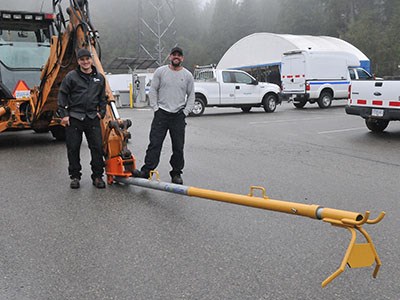Coquitlam public works staff have a new tool in their creek-clearing arsenal, one that they can credit their co-workers with inventing and fabricating.
Crews have typically responded to blocked creeks — usually the work of busy beavers in the Como and Nelson creek systems — in a few different ways but they were often time consuming, dangerous, expensive or all of the above. (Although some of the dams are abandoned crews will relocate any beavers they find before dismantling the debris.)
"The drainage department typically used an old school large treble hook on a rope," said Doug Regehr, a Coquitlam sewer/drainage superintendent. "They'd toss it in the debris and manually pull it out."
But swinging the large hook like a cowboy with a potentially deadly lasso was less than safe, and often ineffective.
Occasionally crews donned waders and cleared debris by hand, but that method came with the potential for the sudden rush of an unblocked creek to knock the worker over.
Regehr said another alternative was renting a long reach excavator — but it was time consuming and expensive for the hourly machine charges, moving the excavator and traffic control requirements.
"The crew was trying to figure out something to make it easier…and they came up with an idea" for a rake-like device that could attach to the backhoe, said Jamie Umpleby, director of public works.
They got Coquitlam welder Kelly Longmore in on the discussion and, after he tried throwing the treble hook he too realized there had to be a better way.
Longmore and sewer/drainage backhoe operator Darren Hecker designed an extendable stinger attachment for the backhoe; it simply attaches on to the rear boom, where the bucket would usually go, and offers a telescopic arm that can be set to different lengths with a locking pin.
Crews have put the device to the test about half a dozen times over the summer and while Longmore continues to refine the design, staff and others are praising its effectiveness.
Umpleby submitted the gadget to the BC Public Works Association's annual conference in September, where it won the Innovation Award and has since garnered attention from other municipalities interested in using the attachment in their communities.
[email protected]
@spayneTC



